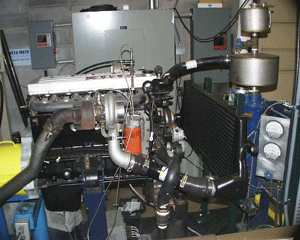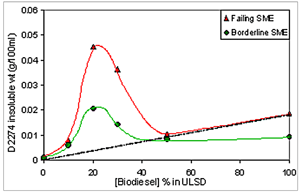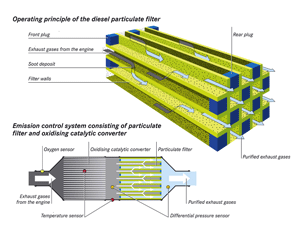Enhancing the Burn




November 10, 2006
BY Ron Kotrba
Diesel particulate filters (DPFs) are requisite emissions hardware for on-road diesel vehicles starting with the 2007 model production year, and there's reason to think biodiesel will do well by it.
In last month's issue of Biodiesel Magazine, National Biodiesel Board (NBB) CEO Joe Jobe stated in his "NBB In Sight" column that B100 and biodiesel blends offer significant advantages-as related to operational efficiency and proper functioning of a DPF-over ultra-low sulfur diesel (ULSD) alone. Jobe cited a recent National Renewable Energy Labortory (NREL) report in which B5 and B20 blended with ULSD were tested, with and without DPFs. The study examined several different things: exhaust back pressures, temperatures, system configurations, fuel blends and "tailpipe-out" emissions.
As Jobe detailed in his column, the NREL study showed that biodiesel helps to reduce the temperature at which particulates are burned off in the soot trap, lowering back pressures caused by a plugged DPF. Furthermore, with a DPF, the B20 blend "provided an additional 67 percent reduction of PM (particulate matter) beyond what the ULSD provided (also with a DPF)," Jobe explained. The NREL report itself, called "Biodiesel Effects on Diesel Particle Filter Performance," states, "It is important to note that this additional PM reduction is only 0.0033 g/bhp-hr (grams per brake horsepower hour), a very small reduction from an already very clean engine." A DPF will trap most soot regardless of the type of fuel used, so whether it traps a hypothetical amount of 95 percent or 95.5 percent PM, the difference-while ostensibly significant-is rather inappreciable, experts say. What is significant is that biodiesel helps lower the temperature at which that trapped soot burns off.
New EPA Regs, Technology
The U.S. EPA's 2007 regulations for particulate matter and NOx require a significant lowering of each, with full NOx control being phased in from 2007 to 2010. The 2007 regs lower particulate-matter emissions (2.5 microns or larger) on new diesel vehicles from 0.1 g/bhp-hr to 0.01 g/bhp-hr, a 10-fold reduction. The 2007 regulations on NOx calls for a fraction of a vehicle manufacturer's fleet to meet full 2010 reductions from 2 g/bhp-hr to 0.2 g/bhp-hr, with that fraction increasing to 100 percent by 2010. Part of 2007's NOx-control strategy includes controlling the fuel-injection timing more accurately, increasing exhaust gas recirculation (EGR) rates, and implementing DPFs. The strategy also includes selective catalytic reduction (SCR) systems or less-refined lean NOx traps. With those regulations in mind, Penn State University (PSU) professor Andre Boehman and Cummins Inc. Technical Advisor Howard Fang help explain how ASTM-spec biodiesel can enhance the operating performance of super-sensitive DPFs.
There's interrelatedness among all inputs, treatments and outputs with a diesel system. Among other things, timing and fuel affect combustion and alter cylinder-out emissions. Those emissions, in turn, affect DPF performance that adjusts NOx content and ultimately NOx abatement equipment. "The particulate filter will [also] alter the composition of the NOx that is in the exhaust," says Boehman, who studies and teaches fuel science and material science engineering. "These catalyzed diesel particulate filters-part of their function is to oxidize the nitric oxide (NO) to nitrogen dioxide (NO2)." He says this is beneficial because NO2 is a more efficient oxidizer of particulates than air, so increasing the concentration of NO2 via the oxidation of NO-whether that's with an oxidation catalyst upstream from a DPF or a catalyzed DPF-lowers the temperature needed to burn off the soot effectively. However, if the soot is completely burned, the NO to NO2 shift in the DPF will create more NO2 downstream, affecting the NOx-control system or the concentration of NOx in tailpipe-out emissions.
DPFs have been in development for years. Many different companies are developing their own system schematics-cordierite or silicon carbide structure, catalyzed or non-catalyzed with an "oxy-cat" upstream-but they all aim to trap soot without hindering the operation of the vehicle through too much exhaust backpressure, which interferes with the combustion process by disallowing chamber exhaust to exit freely from the cylinders.
Diesel engines don't produce a lot of heat, leaving the exhaust rather cool compared to gasoline-engine exhaust. Therefore, to burn off these collected soot particles in the DPF, other factors must come into play. For example, these particles may be disposed of by including a biodiesel blend, a fuel-borne catalyst, an oxidation catalyst or some other mechanism to increase the temperature of the exhaust, lower the temperature at which the soot burns off, or both. This burn-off of the collected soot is called "regeneration," and it keeps the filter from plugging and compromising vehicle performance.
How Biodiesel Lowers Regen Temps
Boehman is also director of the Diesel Combustion and Emissions Laboratory at PSU. "I'm a mechanical engineer by training," he says. "I've been working on cars in some way or another since I was five." Boehman presented at the 2006 National Biodiesel Conference and Expo in San Diego, where he detailed how biodiesel can benefit the functioning of DPFs. Since the conference in early February, NREL published its aforementioned report, part of ongoing research between NREL, the Engine Manufacturers Association and the NBB. This summer, Boehman and his colleagues published "Examination of the Oxidation Behavior of Biodiesel Soot," a somewhat revised version of the material he presented at the February conference. However, it was actually an earlier study on soot and regeneration-published by Boehman and company in 2005-that was the basis for the one that followed this past summer. "They kind of flow together because the observations in the particulate filter study let us dig deeper and deeper to get the source of the difference for the biodiesel-derived soot," he says. "So those two studies are … bookends of a line of inquiry really. They are observations that are part of a stream of work that continues, for which we've gotten some new funding to continue just recently."
Boehman says what he observes in the lab is the propensity of biodiesel soot to oxidize in air. "We consistently saw faster rates of oxidation [and] a lower temperature required for oxidation to begin if we had biodiesel present," he says. "Then we got into trying to figure out what it was about [biodiesel] soot particles-the primary particles-making up this aggregate that was different."
According to his tests, B100 gave an extreme enhancement of oxidation while the effects of B20 were appreciable, too. "We haven't gone and looked at what a threshold impact is," Boehman says. "We haven't had funding for a project where that was the objective." By "threshold," Boehman refers to how much biodiesel is needed in a blend (B2, B5, etc.) to effectively lower the balance-point temperature. According to NREL, the balance-point temperature is the DPF inlet temperature at which the rate of particle oxidation equals that of the soot collection. The "Conclusions, Recommendations and Future Work" section of NREL's report states, "Filter regeneration rate measurements indicate that biodiesel causes a significant increase in regenerate rate, even at the 5 percent blending level."
Fang, who has recently worked with NREL on this subject, gives Biodiesel Magazine some quantitative data on biodiesel and temperatures for DPF functioning. "The balance-point temperature can be lowered by 45 [degrees Celsius] for B20 and 110 [degrees Celsius] for B100," he says. "That's substantial. If you can lower the balance-point temperature, you can lower some fuel [consumption]. It's a fuel economy issue. You can easily burn. You can lower the frequency of the burn process. So it generates some benefits for the engine operations."
With this data in hand, Boehman and his research team have now set out to examine why biodiesel soot structure gives this benefit of enhanced oxidative reactivity by using various characterization techniques in the lab: X-ray diffraction to look at the material's crystallinity; Rama spectroscopy to look at its defects and graphitic character; Fourier transform infrared spectroscopy for examining the presence of oxygen at the surface of the soot particles; and high-resolution electron spectroscopy to look at the nanostructure of the particles. "What we found is that the structure and the oxygen functionality both play a significant role in enhancing the oxidation," Boehman says. "There was something really unique about the B100 particles. They tended to just open up and oxidize like mad."
He compares the properties of biodiesel soot to a wall made of brick and mortar. "It appears that what happens initially is you start to oxidize an outer layer off the particles, and then you kind of attack the mortar and oxidize that amorphous (unstructured) carbon that binds the sort of plates of aromatic material." The inner structure of the soot is referred to as "graphene" layers, which are bound by the amorphous carbon. So the soot binder is burned off, making the "platelets of aromatic material" very mobile. "These plates-graphene layers-rearrange themselves into very long-range ordered structures," Boehman says. "All of that seems to be changed by initially having these oxygen groups on the edges of the particles, which opens them up to oxidation and then they burn more easily … quicker. That's the bottom line-it has significant implications for operating a particulate filter."
Cognizant of Concerns
"Biodiesel is a truly renewable fuel source, the benefits of which I don't need to repeat," Fang says. "But there remain some challenges." He encourages fuel quality; specifically, he refers to the need for complete transesterification to produce quality biodiesel and minimize deposits. The polarity of biodiesel when mixed with ULSD has an antagonistic effect on the formation of deposits-most notably at the B20 level-causing a jump in deposit formation at B20 relative to the supposed linearity between B1 and B100. Also, deposits may foul increasingly pressurized and sensitive fuel injectors, which will affect the fuel spray into the cylinder, subsequently altering the emissions profile of the exhaust to be treated by advanced emissions control systems.
Researchers from NREL, PSU, Cummins and many other institutions continue to study the relationship between these advanced systems and biodiesel blends. The increasing sensitivity of emissions aftertreatment systems, engine technology, injector pressures and emissions regulations all lead experts to believe that, when blended with ULSD and combusted in diesel vehicles of model years 2007 and up, biodiesel fuel quality is more important now than ever before.
Ron Kotrba is a Biodiesel Magazine staff writer. Reach him at rkotrba@bbibiofuels.com or (701) 746-8385.
In last month's issue of Biodiesel Magazine, National Biodiesel Board (NBB) CEO Joe Jobe stated in his "NBB In Sight" column that B100 and biodiesel blends offer significant advantages-as related to operational efficiency and proper functioning of a DPF-over ultra-low sulfur diesel (ULSD) alone. Jobe cited a recent National Renewable Energy Labortory (NREL) report in which B5 and B20 blended with ULSD were tested, with and without DPFs. The study examined several different things: exhaust back pressures, temperatures, system configurations, fuel blends and "tailpipe-out" emissions.
As Jobe detailed in his column, the NREL study showed that biodiesel helps to reduce the temperature at which particulates are burned off in the soot trap, lowering back pressures caused by a plugged DPF. Furthermore, with a DPF, the B20 blend "provided an additional 67 percent reduction of PM (particulate matter) beyond what the ULSD provided (also with a DPF)," Jobe explained. The NREL report itself, called "Biodiesel Effects on Diesel Particle Filter Performance," states, "It is important to note that this additional PM reduction is only 0.0033 g/bhp-hr (grams per brake horsepower hour), a very small reduction from an already very clean engine." A DPF will trap most soot regardless of the type of fuel used, so whether it traps a hypothetical amount of 95 percent or 95.5 percent PM, the difference-while ostensibly significant-is rather inappreciable, experts say. What is significant is that biodiesel helps lower the temperature at which that trapped soot burns off.
New EPA Regs, Technology
The U.S. EPA's 2007 regulations for particulate matter and NOx require a significant lowering of each, with full NOx control being phased in from 2007 to 2010. The 2007 regs lower particulate-matter emissions (2.5 microns or larger) on new diesel vehicles from 0.1 g/bhp-hr to 0.01 g/bhp-hr, a 10-fold reduction. The 2007 regulations on NOx calls for a fraction of a vehicle manufacturer's fleet to meet full 2010 reductions from 2 g/bhp-hr to 0.2 g/bhp-hr, with that fraction increasing to 100 percent by 2010. Part of 2007's NOx-control strategy includes controlling the fuel-injection timing more accurately, increasing exhaust gas recirculation (EGR) rates, and implementing DPFs. The strategy also includes selective catalytic reduction (SCR) systems or less-refined lean NOx traps. With those regulations in mind, Penn State University (PSU) professor Andre Boehman and Cummins Inc. Technical Advisor Howard Fang help explain how ASTM-spec biodiesel can enhance the operating performance of super-sensitive DPFs.
There's interrelatedness among all inputs, treatments and outputs with a diesel system. Among other things, timing and fuel affect combustion and alter cylinder-out emissions. Those emissions, in turn, affect DPF performance that adjusts NOx content and ultimately NOx abatement equipment. "The particulate filter will [also] alter the composition of the NOx that is in the exhaust," says Boehman, who studies and teaches fuel science and material science engineering. "These catalyzed diesel particulate filters-part of their function is to oxidize the nitric oxide (NO) to nitrogen dioxide (NO2)." He says this is beneficial because NO2 is a more efficient oxidizer of particulates than air, so increasing the concentration of NO2 via the oxidation of NO-whether that's with an oxidation catalyst upstream from a DPF or a catalyzed DPF-lowers the temperature needed to burn off the soot effectively. However, if the soot is completely burned, the NO to NO2 shift in the DPF will create more NO2 downstream, affecting the NOx-control system or the concentration of NOx in tailpipe-out emissions.
DPFs have been in development for years. Many different companies are developing their own system schematics-cordierite or silicon carbide structure, catalyzed or non-catalyzed with an "oxy-cat" upstream-but they all aim to trap soot without hindering the operation of the vehicle through too much exhaust backpressure, which interferes with the combustion process by disallowing chamber exhaust to exit freely from the cylinders.
Diesel engines don't produce a lot of heat, leaving the exhaust rather cool compared to gasoline-engine exhaust. Therefore, to burn off these collected soot particles in the DPF, other factors must come into play. For example, these particles may be disposed of by including a biodiesel blend, a fuel-borne catalyst, an oxidation catalyst or some other mechanism to increase the temperature of the exhaust, lower the temperature at which the soot burns off, or both. This burn-off of the collected soot is called "regeneration," and it keeps the filter from plugging and compromising vehicle performance.
How Biodiesel Lowers Regen Temps
Boehman is also director of the Diesel Combustion and Emissions Laboratory at PSU. "I'm a mechanical engineer by training," he says. "I've been working on cars in some way or another since I was five." Boehman presented at the 2006 National Biodiesel Conference and Expo in San Diego, where he detailed how biodiesel can benefit the functioning of DPFs. Since the conference in early February, NREL published its aforementioned report, part of ongoing research between NREL, the Engine Manufacturers Association and the NBB. This summer, Boehman and his colleagues published "Examination of the Oxidation Behavior of Biodiesel Soot," a somewhat revised version of the material he presented at the February conference. However, it was actually an earlier study on soot and regeneration-published by Boehman and company in 2005-that was the basis for the one that followed this past summer. "They kind of flow together because the observations in the particulate filter study let us dig deeper and deeper to get the source of the difference for the biodiesel-derived soot," he says. "So those two studies are … bookends of a line of inquiry really. They are observations that are part of a stream of work that continues, for which we've gotten some new funding to continue just recently."
Boehman says what he observes in the lab is the propensity of biodiesel soot to oxidize in air. "We consistently saw faster rates of oxidation [and] a lower temperature required for oxidation to begin if we had biodiesel present," he says. "Then we got into trying to figure out what it was about [biodiesel] soot particles-the primary particles-making up this aggregate that was different."
According to his tests, B100 gave an extreme enhancement of oxidation while the effects of B20 were appreciable, too. "We haven't gone and looked at what a threshold impact is," Boehman says. "We haven't had funding for a project where that was the objective." By "threshold," Boehman refers to how much biodiesel is needed in a blend (B2, B5, etc.) to effectively lower the balance-point temperature. According to NREL, the balance-point temperature is the DPF inlet temperature at which the rate of particle oxidation equals that of the soot collection. The "Conclusions, Recommendations and Future Work" section of NREL's report states, "Filter regeneration rate measurements indicate that biodiesel causes a significant increase in regenerate rate, even at the 5 percent blending level."
Fang, who has recently worked with NREL on this subject, gives Biodiesel Magazine some quantitative data on biodiesel and temperatures for DPF functioning. "The balance-point temperature can be lowered by 45 [degrees Celsius] for B20 and 110 [degrees Celsius] for B100," he says. "That's substantial. If you can lower the balance-point temperature, you can lower some fuel [consumption]. It's a fuel economy issue. You can easily burn. You can lower the frequency of the burn process. So it generates some benefits for the engine operations."
With this data in hand, Boehman and his research team have now set out to examine why biodiesel soot structure gives this benefit of enhanced oxidative reactivity by using various characterization techniques in the lab: X-ray diffraction to look at the material's crystallinity; Rama spectroscopy to look at its defects and graphitic character; Fourier transform infrared spectroscopy for examining the presence of oxygen at the surface of the soot particles; and high-resolution electron spectroscopy to look at the nanostructure of the particles. "What we found is that the structure and the oxygen functionality both play a significant role in enhancing the oxidation," Boehman says. "There was something really unique about the B100 particles. They tended to just open up and oxidize like mad."
He compares the properties of biodiesel soot to a wall made of brick and mortar. "It appears that what happens initially is you start to oxidize an outer layer off the particles, and then you kind of attack the mortar and oxidize that amorphous (unstructured) carbon that binds the sort of plates of aromatic material." The inner structure of the soot is referred to as "graphene" layers, which are bound by the amorphous carbon. So the soot binder is burned off, making the "platelets of aromatic material" very mobile. "These plates-graphene layers-rearrange themselves into very long-range ordered structures," Boehman says. "All of that seems to be changed by initially having these oxygen groups on the edges of the particles, which opens them up to oxidation and then they burn more easily … quicker. That's the bottom line-it has significant implications for operating a particulate filter."
Cognizant of Concerns
"Biodiesel is a truly renewable fuel source, the benefits of which I don't need to repeat," Fang says. "But there remain some challenges." He encourages fuel quality; specifically, he refers to the need for complete transesterification to produce quality biodiesel and minimize deposits. The polarity of biodiesel when mixed with ULSD has an antagonistic effect on the formation of deposits-most notably at the B20 level-causing a jump in deposit formation at B20 relative to the supposed linearity between B1 and B100. Also, deposits may foul increasingly pressurized and sensitive fuel injectors, which will affect the fuel spray into the cylinder, subsequently altering the emissions profile of the exhaust to be treated by advanced emissions control systems.
Researchers from NREL, PSU, Cummins and many other institutions continue to study the relationship between these advanced systems and biodiesel blends. The increasing sensitivity of emissions aftertreatment systems, engine technology, injector pressures and emissions regulations all lead experts to believe that, when blended with ULSD and combusted in diesel vehicles of model years 2007 and up, biodiesel fuel quality is more important now than ever before.
Ron Kotrba is a Biodiesel Magazine staff writer. Reach him at rkotrba@bbibiofuels.com or (701) 746-8385.
Advertisement
Advertisement
Upcoming Events





